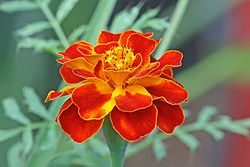- Tagetes patula
-
French marigold 
Scientific classification Kingdom: Plantae (unranked): Angiosperms (unranked): Eudicots (unranked): Asterids Order: Asterales Family: Asteraceae Tribe: Tageteae Genus: Tagetes Species: T. patula Binomial name Tagetes patula
L.Synonyms Tagetes corymbosa Sweet [1]
Tagetes lunulata Ortega [2]
Tagetes remotiflora Kunze [1]
Tagetes signata Bartling[1]
Tagetes tenuifolia Millsp.[1]The French marigold (Tagetes patula) is a species in the daisy family (Asteraceae). It is native to the Americas and South Europe. In Thai it is called ดาวเรืองเล็ก (Dao Ruang Lek).
Contents
Physical characteristics
The flower is an annual, growing to 0.5 m by 0.3 m. It is in flower from July to October, and the seeds ripen in September. The flowers are hermaphrodite (having both male and female organs) and are pollinated by insects. They are noted for attracting wildlife. The leaves of the marigold are coated with oily glands that produce a pungent scent.
Uses
Used mainly as an edging plant on herbaceous borders, it is a low growing plant with flowers of blended red and yellow in most varieties. Liquid concentrate from the flower and leaves is said to be used medicinally in eastern culture to stop nasal bleeding.
Colouring
In addition to colouring foods, yellow dye from the flowers is also used to colour textiles.
Fragrance
The whole plant is harvested when in flower and distilled for its essential oil. The oil is used in perfumery; it is blended with sandalwood oil to produce 'attar genda' perfume. About 35 kilograms of oil can be extracted from 1 hectare of the plant (yielding 2,500 kg of flowers and 25,000 kg of herbage). The oil is also being investigated for antifungal activity, including treatment of candidiasis[3] and treating fungal infections in plants.[4][5]
Gardening
The plant is used in companion planting for many vegetable crops. Its root secretions kill nematodes in the soil and it is said to repel harmful insects, such as white fly amongst tomatoes.[6]
References
- ^ a b c d USDA Natural Resources Conservation Service. "PLANTS Database". http://plants.usda.gov/java/profile?symbol=TAPA. Retrieved 2007-09-04.
- ^ USDA, ARS, National Genetic Resources Program. "Germplasm Resources Information Network - (GRIN) Online Database, National Germplasm Resources Laboratory, Beltsville, Maryland.". http://www.ars-grin.gov/cgi-bin/npgs/html/taxon.pl?36202. Retrieved 2007-09-04.
- ^ B. K. Dutta, S. Karmakar, A. Naglot, J. C. Aich and M. Begam (March 2007). "Anticandidial activity of some essential oils of a mega biodiversity hotspot in India". Mycoses 50 (2): 121–124. doi:10.1111/j.1439-0507.2006.01332.x. PMID 17305775.
- ^ Mares D, Tosi B, Poli F, Andreotti E, Romagnoli C. (2004). "Antifungal activity of Tagetes patula extracts on some phytopathogenic fungi: ultrastructural evidence on Pythium ultimum". Microbiol Res. 159 (3): 295–304. doi:10.1016/j.micres.2004.06.001. PMID 15462529.
- ^ C. Romagnoli1, R. Bruni, E. Andreotti, M. K. Rai, C. B. Vicentini and D. Mares (April 2005). "Chemical characterization and antifungal activity of essential oil of capitula from wild Indian Tagetes patula L.". Protoplasma 225 (1–2): 57–65. doi:10.1007/s00709-005-0084-8. PMID 15868213.
- ^ Sustainable Gardening Australia, Companion Planting [1] retrieved on 8 June 2009
Categories:- Flora of Mexico
- Flora of Nicaragua
- Tageteae
Wikimedia Foundation. 2010.
